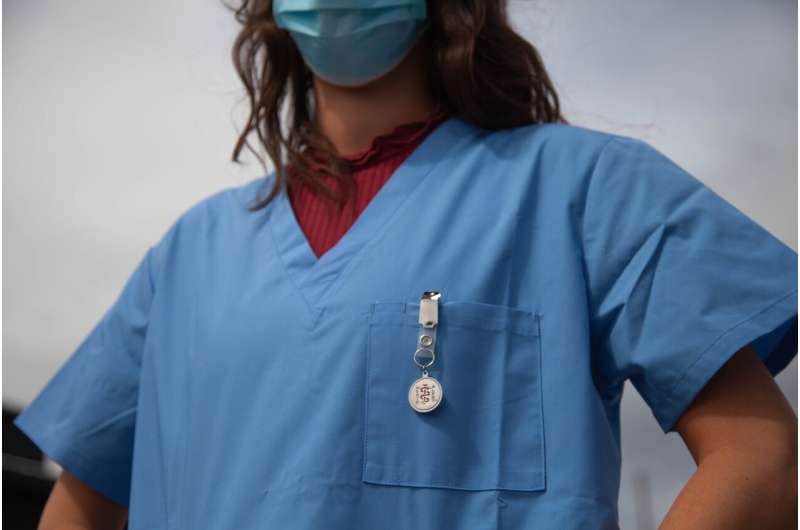Credit: Unsplash/CC0 Public Domain
Research has shown that, when nurses feel they are being prevented from taking a morally justifiable action or achieving an ethical outcome, it contributes to poor mental health, burnout, and intent to leave one's job. Surveys from the COVID-19 pandemic found that a shortage of personal protective equipment (PPE) and lack of perceived support from hospital administrators were associated with higher levels of this moral distress.
University of Pennsylvania School of Nursing researchers and their collaborators hypothesized that nurses working in hospitals where Black patients predominantly access care—which they call Black-serving hospitals, or BSHs—would suffer greater moral distress, since these hospitals were disproportionately affected by the pandemic and generally have fewer resources.
In a study published in the journal Nursing Outlook, they found that the percentage of nurses experiencing moral distress was twice as high in hospitals with the highest share of Black patients, and that poor leadership communication contributed to the greater moral distress.
"The nurses had poorer support from their leaders and poorer access to personal protective equipment, they're caring more frequently for COVID patients, and they're reporting greater moral distress, all of which is an inequitable burden for the nurses in those hospitals," says lead author Eileen T. Lake, professor of nursing at Penn and associate director of the Center for Health Outcomes and Policy Research (CHOPR). She says this is a social justice issue for the nurses.
While the survey data were collected from 3,675 nurses at 90 hospitals in March and April 2021, the paper notes that Black-serving hospitals are also likely to be disproportionately impacted in the post-pandemic nurse staffing crisis. Lake says that, since burnout is largely driven by workload and work environment, she expected that post-pandemic burnout would be worse in hospitals serving a higher share of Black patients.
To survey acute care nurses, the researchers recruited hospitals through the National Database of Nursing Quality Indicators, and they used data from the 2019 Medicare Provider Analysis and Review to classify hospitals by the percentage of Black patients from low-BSH to high-BSH.
The nurses were presented with nine moral distress situations and asked to rate the frequency and extent of distress. Two conditions they were surveyed on, for example, were "caring for patients who die during a hospitalization without family and/or clergy present" and "witnessing a lack of respect among health care team for patients from vulnerable populations or minority groups."
The researchers found that 4% of nurses in the high-BSH category of hospitals experienced high moral distress compared to 2% in the low-BSH category, nurses showed less moral distress in hospitals with better leadership communication, and nurses working in high-BSH hospitals were more likely to disagree that leadership communication was transparent, effective, or timely.
Nurses in high-BSH hospitals also reported caring for patients with COVID-19 more frequently and experiencing worse access to PPE.
"Moral distress remains an ongoing bioethical issue, and we are losing qualified nurses because of it," says co-author Connie M. Ulrich, the Lillian S. Brunner Chair in Medical and Surgical Nursing at Penn Nursing.
"This study highlights the need to close the inequity gaps in BSHs and find innovative ways to support nurses in the day-to-day care of patients and families and lessen the physical and emotional burdens they carry."
The authors acknowledge there was much uncertainty during the acute phase of the pandemic and information changed daily, but they write that disseminating email newsletters and organizing staff huddles could strengthen leadership communication. They also put forth the idea of a BSH designation through the Centers for Medicare and Medicaid Services so that hospitals exceeding a certain percentage of Black patients could acquire greater resources.
"One of the interesting aspects of this paper is that it points to managerial factors as an important part of the solution to the problem of moral distress among nurses," says co-author Jeannette A. Rogowski, an economist at Penn State University.
"For hospitals that are resource constrained, such as many BSH hospitals, increasing nursing staff may be difficult. However, fewer resources are likely needed to enact managerial interventions such as increasing leadership communication."
Lake explains that she and Rogowski began working together two decades ago to research why low-birth-weight Black infants had worse outcomes than their white counterparts. They found these outcomes were associated with lower nurse staffing levels and poorer work environments in neonatal intensive care units. Over the years, Lake says, they decided to broaden their focus to ask about outcomes in high-BSH hospitals more broadly.
About eight years ago, they started working with Jessica G. Smith, a former postdoctoral research fellow at CHOPR who is now an assistant professor of nursing at the University of Texas at Arlington. Smith is a co-author on the new paper along with Ulrich, a bioethicist with experience studying moral distress. Another co-author, Nehemiah Weldeab of the Department of Behavioral Health Sciences in Penn Nursing, is a data analyst.
"The multidisciplinary nature of this team was essential to producing the paper and the insights that it brought regarding the role of management in reducing moral distress among nurses in BSH hospitals," Rogowski says.
More information: Eileen T. Lake et al, Nurses' moral distress and leadership communication in hospitals serving Black patients during COVID-19, Nursing Outlook (2024). DOI: 10.1016/j.outlook.2024.102189
Provided by University of Pennsylvania
























